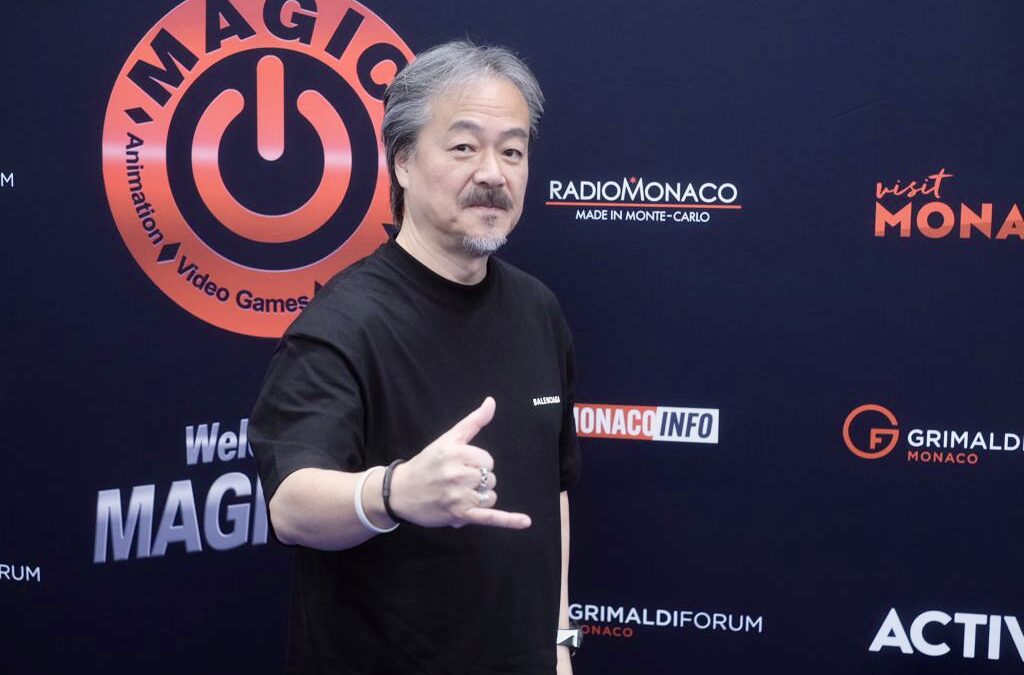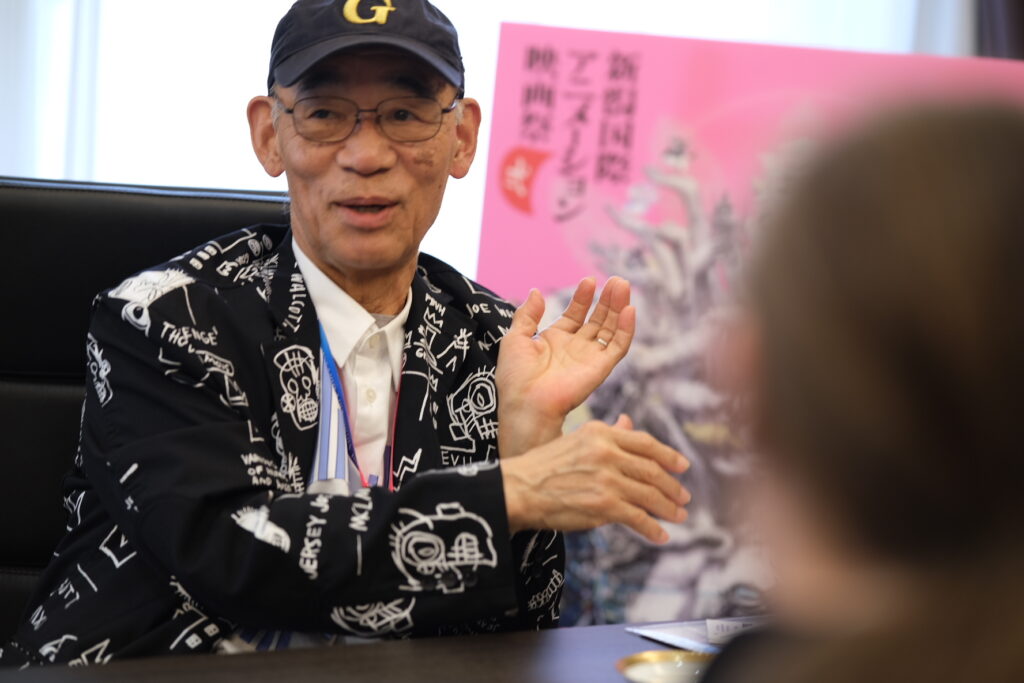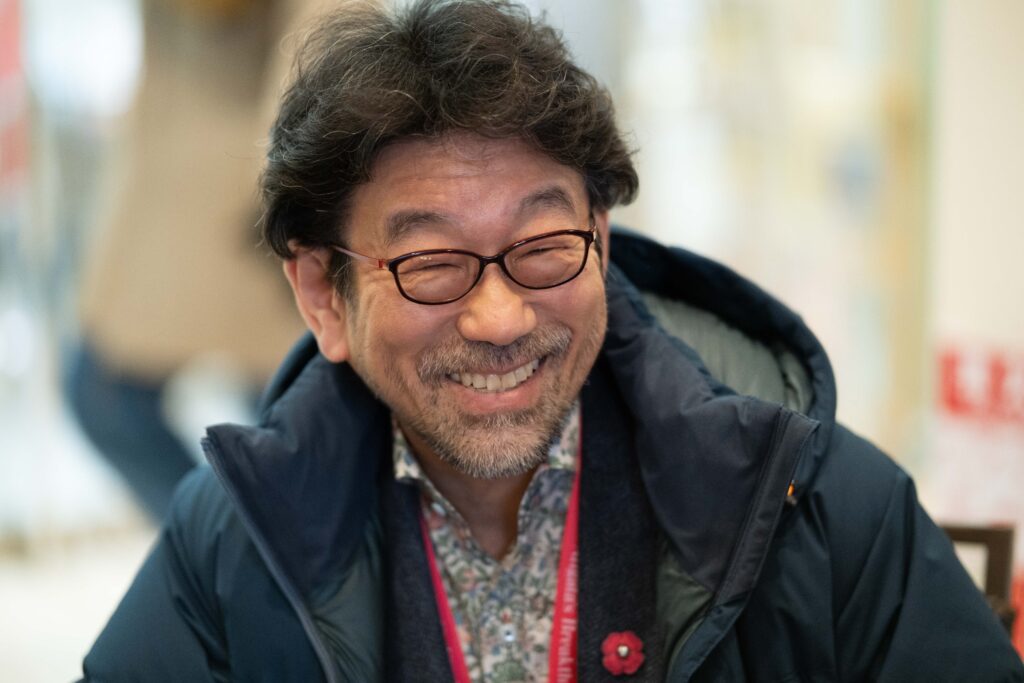In February, we had the chance to meet the great game designer behind Final Fantasy, Hironobu Sakaguchi, at the 2023 edition of the MAGIC (Monaco Anime Game International Conference), organized by Shibuya Productions.
Actually, the first time I met him was many years before the creation of fullfrontal.moe, when I was just a teenager. Sakaguchi came to Paris for a signing session and a conference about his game The Last Story in 2012. Little me woke up at dawn to ensure he would be among the first in line. It was my first time meeting a creator of something I love, and it is still a very important memory to me. Meeting him pushed me to dedicate myself to my passions and ultimately co-found this website, so interviewing Sakaguchi 11 years later is a great honor, and I’m very grateful for this opportunity.
Hironobu Sakaguchi is one of the most iconic figures of the Japanese video game industry, being the father of one of the most successful RPG series in history, Final Fantasy. Not only did he have an immense role in the creation of the first nine titles of the series, but he was also an important figure at Squaresoft which released tons of cult classic Japanese RPGs from the end of the 80s until the beginning of the 2000s when the company merged with Enix, one of its biggest competitors. During all of his career at Squaresoft, Sakaguchi helped to support the creativity of a large number of incredible game designers, like Akitoshi Kawazu, the creator of the SaGa series, Tetsuya Takahashi, the creator of the Xeno series or even Tetsuya Nomura who admitted that the complex storyline of the Kingdom Hearts series came from a suggestion from Sakaguchi. Following the financial failure of his extremely ambitious movie Final Fantasy: The Spirits Within, he left Square Enix in 2003. It is unanimously agreed that the studio could never really reclaim the greatness it once had; legendary Final Fantasy director Yoshinori Kitase and Tetsuya Nomura once even said that Sakaguchi provided a singular creative voice for the company, which was never reclaimed after he left.
But Hironobu Sakaguchi hasn’t stopped creating incredible RPGs since then. He created his own studio Mistwalker and worked on exclusive RPG titles at the release of the Xbox 360, such as Blue Dragon and Lost Odyssey, both with the help of famous Shônen Jump mangaka Akira Toriyama and Takehiko Inoue. In 2011, he released one of the most iconic RPGs on the Nintendo Wii, The Last Story. After that, he explored mobile games with Party Wave, inspired by his passion for surfing he got while living in Hawaii, and the successful card game Terra Battle. Recently, he worked with Apple to release Fantasian for the Apple Arcade, which is clearly the most ambitious game on their platform.
We were extremely pleased to sit down and talk with Mr. Hironobu Sakaguchi to discuss his incredible career with him.
Like our content? Feel free to support us on Ko-Fi!
While you worked at Squaresoft, the company released an unbelievable amount of video game masterpieces. It was often said that you were the voice between the creative people and the company managers. How did you manage to create an environment with such artistic freedom, and how did you make the creative people give the best of themselves?
Hironobu Sakaguchi: Well, actually, it was very hard to manage both of the environments. That’s one of the reasons why I left Square in the first place. I wanted to focus more on the creative side and less on the management.
Final Fantasy as a series has a very dramatic, tear-jerking side, even in the older titles. Where did that intention to make people cry come from at the time, and what techniques have you used to create that effect with small 2D sprites?
Hironobu Sakaguchi: Well, there are two things. The first one is the scenario and story that we gave a lot of importance to. But we also gave a lot of importance to the artistic side, and even with pixels, in those very small drawings, you can bring out a lot of emotions with small details like a character bowing or raising his hand, those kinds of things and that’s how we created that dramatic tone. Also, for the first two Final Fantasy, programmers made all the scenes inside the code. They were told about the direction, the staging, and the effects, and then they made the characters move directly in the code. But after that, we developed an event scripting system so that I could write all the scripted scenes, character movements, and other things in scripts that were separated from the game’s actual code.
Nasir Gebelli is an Iranian-American game developer recruited at the beginning of the Final Fantasy series and contributed to the first three games. I know that you really liked his games. How did you meet him? What did you like about his works, and what was his contribution to the series?
Hironobu Sakaguchi: I discovered video games when I was a student on my Apple II, and he had made a lot of games for it, like 3D action shooting games; he was already a video game star. I met him completely by chance, and then we were able to work with him on Jumpin’ Jack which was a Mario-like platformer but in 3D, as well as a racing game named Highway Star. For the Final Fantasy games, he was programming everything besides the battles, which were programmed by the Japanese team.
Final Fantasy IV has brought many storytelling innovations to the series. Takashi Tokita once said he was inspired by stage plays. Can you tell us more about the stage play influence of Final Fantasy IV and the series as a whole?
Hironobu Sakaguchi: Final Fantasy IV was released on the Super Famicom. The hardware was completely different, and we could make completely new kinds of visuals. But we weren’t particularly inspired by stage plays; we just wanted to improve the overall experience and tried our best to make something even better than Final Fantasy 1, 2, and 3.
Final Fantasy VII has brought a revolutionary way of creating RPGs, with 3D characters running on 2D pre-rendered backgrounds of different angles. Where did that idea come from, and why did you choose this instead of making the game full 3D-like?
Hironobu Sakaguchi: Some parts of Final Fantasy VII are more in 3D, but since we were on the Play Station 1, if we made a 100% 3D game, it wouldn’t have been the same quality as with pre-rendered backgrounds because of low polygons. We also wouldn’t be able to give interesting and detailed textures to the visuals. The backgrounds were rendered in a 3D engine, but the game was a 2D image, so we could get the best visual quality while keeping a 3D feeling to it.
And there is also that cinematographic side that you can feel thanks to the different camera angles of the backgrounds that you cannot get in full 3D games.
Hironobu Sakaguchi: Yes, completely; there is also that.
Squaresoft was filled with highly skilled artists. I particularly think about Yasuyuki Honne, who worked on map designs and is an extraordinary painter. How were artists recruited at Squaresoft then, and how did you find such talents?
Hironobu Sakaguchi: On Final Fantasy VI, we already had very talented graphics artists like Tetsuya Takahashi, Hideo Minaba, and Yusuke Naora. But we didn’t really have a research process for artists; artists themselves were coming to work for Squaresoft. When Final Fantasy V was released on the Super Famicom, the game was really good, so many people came to us and wanted to join us to work on future projects.
How have you met Takehiko Inoue at the time of Lost Odyssey, and how was it to work with him?
Hironobu Sakaguchi: I was already very close with Shueisha as a whole at the time. Since Final Fantasy IV, I frequently went to their HQ because there was a special page in the Shônen Jump called a fukurotoji. It is a page you had to open with scissors to obtain hidden information, and inside there were pieces of information about the new Final Fantasy game. It benefitted both sides, but that was a big promotion for Final Fantasy. So I was already a friend of Takehiko Inoue, I was regularly seeing him, having drinks together, but he didn’t want to work on video games at first. I had to talk with him for a whole year about the concepts of the Lost Odyssey project, and finally, he said that it was interesting and that he would like to work on it.
Did his manga Vagabond influence Lost Odyssey?
Hironobu Sakaguchi: Not particularly. Vagabond is about Musashi Miyamoto, a very famous samurai, so when he makes characters, it might remind you of Vagabond, and you could get impressions like that.
Where did the idea of making backgrounds with dioramas in Fantasian come from? Was it a will to return to a style like Final Fantasy VII, VIII, and IX, but in a different way?
Hironobu Sakaguchi: Actually, I’ve always been a big fan of Gunplas or other models, but I never thought of using that in a game before. Nowadays, it’s possible, thanks to the image quality of smartphones. Even though the screen is small, you can still see beautiful details in the photos.
It was said that in an old draft of Final Fantasy VII, the main character was supposed to be a character named Detective Joe. Can you tell us more about him? What kind of character was he supposed to be, and what was his role in the story?
Hironobu Sakaguchi: Hum… I don’t really remember that. Sorry.
You worked in many different environments and periods of time, working on big, ambitious projects for home consoles and smaller ones for mobile games, working for Square and different publishers while working at Mistwalker. What was the period when you felt you and your team had the most creative flexibility?
Hironobu Sakaguchi: I think there weren’t any differences because when I work as a producer, usually, there are a lot of creative checks from the higher-ups for scenarios, etc., but I don’t want any of those. So when I work on a project, I put in my contracts that I want full creative control, with no checks or verifications of any sort. So, personally, in my case, I’ve always been able to make my projects the way I like, with a lot of freedom.
On your Twitter account, we can see that you love playing Final Fantasy XIV. What do you think about Naoki Yoshida’s work in general, and what do you expect from Final Fantasy XVI?
Hironobu Sakaguchi: Yeah, I really like playing Final Fantasy XIV, it’s an MMORPG, so there is all that community aspect that I really enjoy. I’ve already met Naoki Yoshida many times; he is very serious and hard-working. He is an excellent producer and director, and I really appreciate him and what he does. He also has huge respect for the older Final Fantasy titles; he genuinely understands the soul of those games, so yes, I have high expectations for Final Fantasy XVI, indeed!
You and the developer team talked about game cartridge sizes in old interviews. Final Fantasy IV was only 8MB and Final Fantasy V 16MB. What sacrifices have you made to make the games fit the cartridges?
Hironobu Sakaguchi: Yes, particularly on Final Fantasy I to VI; since we worked on Family Computer cartridges, we had to work cautiously. First, we would make the memory maps for the ROM cartridges to decide how much capacity we would assign for each part. This step of development is as important as the scenario. We were all scrambling for the capacity initially since everyone wanted to insert their stuff in the game, but my role was to find balance by talking with everyone. We were doing this as early as the writing of the scenario.
Final Fantasy VI is the Final Fantasy game with the most Yoshitaka Amano look. Even the colors chosen for the game as a whole remind me a lot of the color palette of Amano’s paintings. How did you manage to bring Amano’s style the most to the screen, and how difficult was it?
Hironobu Sakaguchi: Pixel graphic designers made a lot of effort in that episode of the series, yes. Kazuko Shibuya and others were responsible for the pixel art and were huge fans of Yoshitaka Amano. They knew that was difficult, but they really did their best to convey the feel of Amano’s art in pixel art.
What do you think about the remake of Final Fantasy VII?
Hironobu Sakaguchi: Yoshinori Kitase, who was making movie editing as a student, is in charge of the remake. He worked on Final Fantasy games since the sixth entry, and the series got a lot better thanks to his talent. Now he is doing a remake with the same spirit as when he made the original, but with current technology, he is really at his full potential since it lets you make games with movie-quality graphics. I believe in his talent to create the best possible result.
Transcript by Emilia Hoarfrost.
Translation by Noëlla Bonnier
We wish to heartfully thank Mr. Sakaguchi for his time, as well as Sophie Fabrello from Shibuya Production and the whole staff from Shibuya Production and MAGIC Monaco for this opportunity.
Like our content? Feel free to support us on Ko-Fi!
You might also be interested in
Oshi no Ko & (Mis)Communication – Short Interview with Aka Akasaka and Mengo Yokoyari
The Oshi no Ko manga, which recently ended its publication, was created through the association of two successful authors, Aka Akasaka, mangaka of the hit love comedy Kaguya-sama: Love Is War, and Mengo Yokoyari, creator of Scum's Wish. During their visit at the...
Ideon is the Ego’s death – Yoshiyuki Tomino Interview [Niigata International Animation Film Festival 2024]
Yoshiyuki Tomino is, without any doubt, one of the most famous and important directors in anime history. Not just one of the creators of Gundam, he is an incredibly prolific creator whose work impacted both robot anime and science-fiction in general. It was during...
“Film festivals are about meetings and discoveries” – Interview with Tarô Maki, Niigata International Animation Film Festival General Producer
As the representative director of planning company Genco, Tarô Maki has been a major figure in the Japanese animation industry for decades. This is due in no part to his role as a producer on some of anime’s greatest successes, notably in the theaters, with films...





Trackbacks/Pingbacks